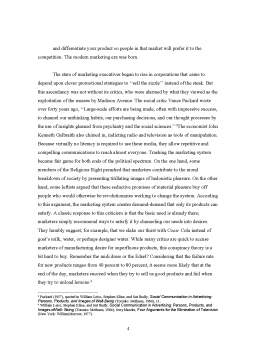Extras din referat
Welcome to consumerspace, where reality is branded. Where we avidly search for the products and services that will define who we are and who we want to be. Where we are what we buy—literally. This essay is about that branded reality. In the pages to come, we’ll explore what that means, both for those who buy the dream and for those who sell it.
In the video game Cool Borders 3, characters ride past Butterfinger candy bar banners and wear Levi’s jeans while attempting to beat opponents’ times that are recorded on Swatch watches. A Sony Play-Station game called Psybadek outfits its main characters in Vans shoes and clothing. According to a Sony executive, ‘‘we live in a world of brands. We don’t live in a world of
generics. . . . If a kid is bouncing a basketball in a video game, to us it makes sense that it should be a Spalding basketball.’’ It isn’t news that products matter. But, the extent to which we rely today upon brands to define our identities and to make sense of the world around us is extraordinary. Skeptical? Consider the five people who are being paid $800 each by a British marketing firm to legally change their names for one year to Turok. He is the hero of a video game about a time-traveling American Indian who slays bionically enhanced dinosaurs. The company hopes to turn each of the chosen few into an ambassador for the game, since at the least, each warrior wannabe will have to patiently explain the new moniker to friends, loved ones, and curious strangers. According to a company spokesman, they will be ‘‘. . . walking, talking, living, breathing advertisements.’’ This experiment in identity marketing follows an earlier promotion by a Web site called Internet Underground Music Archive (IUMA) that paid a Kansas couple $5,000 to name their baby boy Iuma. In ‘‘the old days,’’ we used products strategically to manage the impressions we made on others. The quest for status is very much alive today, but brands do a lot more than help us keep up with the Joneses. Today, we use these material props to look good to ourselves, to validate our identities, to find meaning in our social environments. Today, we buy products because of what they mean, rather than what they do.Our quest to define our very identities with the aid of brands that have deep meanings to us reflects a transition from marketerspace to consumerspace. In marketerspace, companies create mass-produced products targeted to the preferences of homogeneous market segments .In consumerspace, each of us charts our own identity by picking and choosing the brands that speak to us. In marketerspace, companies sell to us. In consumerspace, they sell with us. In the chapters to come, we’ll see how things work in consumerspace. Along the way, we’ll highlight opportunities for marketers who appreciate how what they sell truly has become part of what we are.
In the beginning, there was marketerspace, a commercial system where producers dictated what we buy, when, and where. Henry Ford’s production-line approach to manufacturing revolutionized the business world by making mass-produced Model T cars available to virtually everyone, even to the workers who actually built the ‘‘Tin Lizzie.’’ The workingman could now reap the fruits of his labor, but the selection was pretty bland. As Ford famously observed, you can have any color Model T you want—as long as it’s black. Drivers back then didn’t seem to mind. By 1921, the Model T Ford controlled 60 percent of the automobile market. But that was before people could
choose from among a Ford, Maserati, or Hummer. A heavy-handed approach works fine in a seller’s market, but along came the Great Depression. As money got very tight, shoppers got very picky about parting with their scarce cash. Desperate to move their inventories, companies turned to the hard sell. This strategy continued on past World War II, when American factories that had dutifully increased their capacity to churn out supplies for the war effort once again turned their attention to producing consumer goods. The great industrial machine created in wartime had to be fed in peacetime as well.
By the 1950s, the competition for consumers’ pocketbooks got too heated to depend upon the skills of super salesmen who could ‘‘sell ice to Eskimos.’’ Once again the automotive industry led the way. This time it was General Motors that created a new paradigm by pushing the concept of market segmentation: Don’t try to sell everyone a Chevrolet.
Preview document
Conținut arhivă zip
- Conquering Consumerspace.doc







